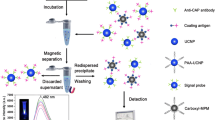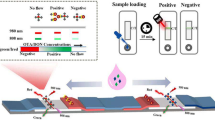Abstract
A rapid and sensitive immunoassay for the simultaneous detection of thiabendazole (TBZ) and carbendazim (CBZ) was developed by using magnetic nanoparticles (MNPs) and two-color upconversion nanoparticles (UCNPs). The anti-thiabendazole and anti-carbendazim antibody were linked to NaYF4:Yb, Tm (emission at 474 nm) and NaYF4:Yb, Er (emission at 542 nm) UCNPs as multicolor signal probe, respectively. The thiabendazole and carbendazim coating antigen were connected to magnetic microspheres as capture probe, respectively. Based on a competitive format, capture probes compete with analytes to combine corresponding signal probes. Under excitation at 980 nm, the formed competitive immune-complex fluorescent signal at 474 and 542 nm indicates the concentration of thiabendazole and carbendazim, respectively. Under the optimal conditions, the 50% inhibiting concentration (IC50) and limit of detection (LOD, IC10) were 2.21 and 0.083 ng/mL for thiabendazole and 1.18 and 0.075 ng/mL for carbendazim, respectively. The average recoveries of thiabendazole and carbendazim in foods, including oyster mushroom, shiitake mushrooms, oranges and orange juice, ranged from 83.6 to 100.9% with the coefficient of variance (CV) of 1.0–9.8% for thiabendazole and ranged from 89.6 to 105.9% with the CV of 2.5 to 9.1% for carbendazim. This multiplexed analysis format has potential applications for rapid, efficient detection of multiple food risk factors.
Graphic abstract

Schematic diagram of the detection scheme






Similar content being viewed by others
References
Zheng F, Xiao HM, Zhu QF, Yu QW, Feng YQ (2019) Profiling of benzimidazoles and related metabolites in pig serum based on SiO2@NiO solid-phase extraction combined precursor ion scan with high resolution orbitrap mass spectrometry. Food Chem 284:279–286. https://doi.org/10.1016/j.foodchem.2019.01.071
Li HH, Hassan MM, Wang JJ, Wei WY, Zou M, Ouyang Q, Chen QS (2021) Investigation of nonlinear relationship of surface enhanced Raman scattering signal for robust prediction of thiabendazole in apple. Food Chem. https://doi.org/10.1016/j.foodchem.2020.127843
Özcan A, Hamid F, Özcan AA (2021) Synthesizing of a nanocomposite based on the formation of silver nanoparticles on fumed silica to develop an electrochemical sensor for carbendazim detection. Talanta. https://doi.org/10.1016/j.talanta.2020.121591
Zhu YY, Zhang YS, Liu N (2020) The Dis1/Stu2/XMAP215 family gene FgStu2 is involved in vegetative growth, morphology, sexual and asexual reproduction, pathogenicity and DON production of Fusarium graminearum. Front Microbiol. https://doi.org/10.3389/fmicb.2020.545015
Long ZN, Wang XG, Wang YJ, Dai HW, Li CH, Xue YF, Deng YF, Zhang HP, Yu YL, Fang H (2021) Characterization of a novel carbendazim-degrading strain Rhodococcus sp. CX-1 revealed by genome and transcriptome analyses. Sci Total Environ. https://doi.org/10.1016/j.scitotenv.2020.142137
Gao YQ, Wang Y, Li J, Shang SB, Song ZQ (2018) Improved application of natural forest product terpene for discovery of potential botanical fungicide. Ind Crops Prod 126:103–112. https://doi.org/10.1016/j.indcrop.2018.10.008
Ilyushina NA (2020) Cytogenetic effects of carbendazim on mouse bone marrow cells. Russ J Genet 56(10):1193–1202. https://doi.org/10.1134/S1022795420090094
Zhang XJ, Zhang P, Perez RV, Souders CL, Martyniuk CJ (2020) Assessing the toxicity of the benzamide fungicide zoxamide in zebrafish (Danio rerio): towards an adverse outcome pathway for beta-tubulin inhibitors. Environ Toxicol Pharmacol. https://doi.org/10.1016/j.etap.2020.103405
Marete GM, Shikuku VO, Lalah JO, Mputhia J, Wekesa VW (2020) Occurrence of pesticides residues in French beans, tomatoes, and kale in Kenya, and their human health risk indicators. Environ Monit Assess. https://doi.org/10.1007/s10661-020-08662-y
Pavlović DM, Kraljević TG, Pavić R, Mrđa J (2019) Determination of anthelmintic pharmaceuticals in wastewater by solid-phase extraction and thin-layer chromatography. Akadémiai Kiadó 32(5):421–429. https://doi.org/10.1556/1006.2019.32.5.10
Tejada-Casado C, Hernández-Mesa M, del Olmo-Iruela M, García-Campaña AM (2016) Capillary electrochromatography coupled with dispersive liquid-liquid microextraction for the analysis of benzimidazole residues in water samples. Talanta 161:8–14. https://doi.org/10.1016/j.talanta.2016.08.012
Τsialla Z, Ucles-Moreno A, Petrou P, Fernandez-Alba AR, Κakabakos SE (2015) Development of an indirect enzyme immunoassay for the determination of thiabendazole in white and red wines. Int J Environ Anal Chem 95(13):1299–1309. https://doi.org/10.1080/03067319.2015.1100727
Yan HJ, Liu LQ, Xu NF, Kuang H, Xu CL (2015) Development of an immunoassay for carbendazim based on a class-selective monoclonal antibody. Food Hydrocoll 26(5):659–670. https://doi.org/10.1080/09540105.2015.1007446
Li XX, Liu L, Fu Y, Chen HD, Abualrejal MMA, Zhang H, Wang ZX, Zhang HM (2020) Peptide-enhanced tumor accumulation of upconversion nanoparticles for sensitive upconversion luminescence/magnetic resonance dual-mode bioimaging of colorectal tumors. Acta Biomater 104:167–175. https://doi.org/10.1016/j.actbio.2020.01.003
Hong AR, Kim Y, Lee TS, Kim S, Lee K, Kim G, Jang HS (2018) Intense red-emitting upconversion nanophosphors (800 nm-driven) with a core/double-shell structure for dual-modal upconversion luminescence and magnetic resonance in vivo imaging applications. ACS Appl Mater Interfaces 10(15):12331–12340. https://doi.org/10.1021/acsami.7b18078
Zhang WN, Li J, Lei HX, Li BJ (2020) Temperature-dependent Förster resonance energy transfer from upconversion nanoparticles to quantum dots. Opt Express 28(8):12450–12459. https://doi.org/10.1364/OE.386601
Chen S, Wu J, Cai A, Gonzalez N, Yin RY (2020) Towards minimally invasive deep brain stimulation and imaging: a near-infrared upconversion approach. Neurosci Res 152:59–65. https://doi.org/10.1016/j.neures.2020.01.005
Rao PP, Wang L, Cheng Y, Wang X, Li HT, Zheng GX, Li ZL, Jiang C, Zhou Q, Huang CX (2020) Near-infrared light driven tissue-penetrating cardiac optogenetics via upconversion nanoparticles in vivo. Biomed Opt Express 11(3):1401–1416. https://doi.org/10.1364/BOE.381480
Abualrejal MMA, Eid K, Abdullah AM, Numan AA, Chen HD, Zhang H, Wang ZX (2020) Smart design of exquisite multidimensional multilayered sand-clock-like upconversion nanostructures with ultrabright luminescence as efficient luminescence probes for bioimaging application. Anal Sci Based Micro Nanomater Microchim Acta. https://doi.org/10.1007/s00604-020-04521-2
Zhang QC, Liu YL, Wang XY, Li HM, Chen JY (2017) In situ synthesis of a magnetic graphene platform for the extraction of benzimidazoles from food samples and analysis by high-performance liquid chromatography. J Anal Methods Chem. https://doi.org/10.1155/2017/3018198
Zhang B, Li HH, Pan WX, Chen QS, Ouyang Q, Zhao JW (2017) Dual-color upconversion nanoparticles (UCNPs)-based fluorescent immunoassay probes for sensitive sensing foodborne pathogens. Food Anal Methods 10(6):2036–2045. https://doi.org/10.1007/s12161-016-0758-1
Grebenik EA, Generalova AN, Nechaev AV, Khaydukov EV, Mironova KE, Stremovskiy OA, Lebedenko EN, Zvyagin AV, Deyev SM (2014) Specific visualization of tumor cells using upconversion nanophosphors. Acta Nat 6(4):48–53. https://doi.org/10.32607/20758251-2014-6-4-48-53
Wu SJ, Duan N, Zhu CQ, Ma XY, Wang M, Wang ZP (2011) Magnetic nanobead-based immunoassay for the simultaneous detection of aflatoxin B-1 and ochratoxin A using upconversion nanoparticles as multicolor labels. Biosens Bioelectron 30(1):35–42. https://doi.org/10.1016/j.bios.2011.08.023
Hussain A, Pu HB, Hu BX, Sun DW (2021) Au@Ag-TGANPs based SERS for facile screening of thiabendazole and ferbam in liquid milk. Spectrochim Acta Part A Mol Biomol Spectrosc. https://doi.org/10.1016/j.saa.2020.118908
Boroduleva AY, Manclús JJ, Montoya Á, Eremin SA (2018) Fluorescence polarization immunoassay for rapid screening of the pesticides thiabendazole and tetraconazole in wheat. Anal Bioanal Chem 410(26):6923–6934. https://doi.org/10.1007/s00216-018-1296-z
Li Q, Dou XW, Zhao XS, Zhang L, Luo JY, Xing XY, Yang MH (2019) A gold/Fe3O4 nanocomposite for use in a surface plasmon resonance immunosensor for carbendazim. Microchim Acta. https://doi.org/10.1007/s00604-019-3402-0
Funding
This study was supported by the Natural Science Foundation of Tianjin (18JCQNJC84400) and National Natural Science Foundation (No. 31301487).
Author information
Authors and Affiliations
Corresponding authors
Ethics declarations
Conflict of interest
The authors declare that they have no conflict of interest.
Informed consent
Informed consent was obtained from all individual participants included in the study.
Research involved with human or animals participants
This article does not contain any studies with human participants or animals performed by any of the authors.
Additional information
Publisher's Note
Springer Nature remains neutral with regard to jurisdictional claims in published maps and institutional affiliations.
Rights and permissions
About this article
Cite this article
Wang, M., Zhu, W., Zhao, L. et al. Simultaneous detection of thiabendazole and carbendazim in foods based on two-color upconversion and magnetic separation nanoparticles fluorescence immunoassay. Eur Food Res Technol 248, 85–94 (2022). https://doi.org/10.1007/s00217-021-03853-4
Received:
Revised:
Accepted:
Published:
Issue Date:
DOI: https://doi.org/10.1007/s00217-021-03853-4




